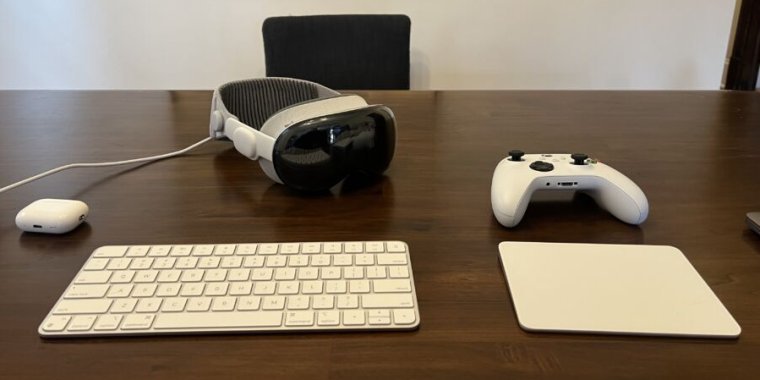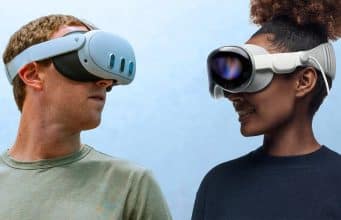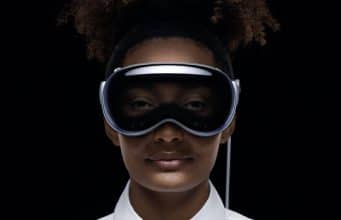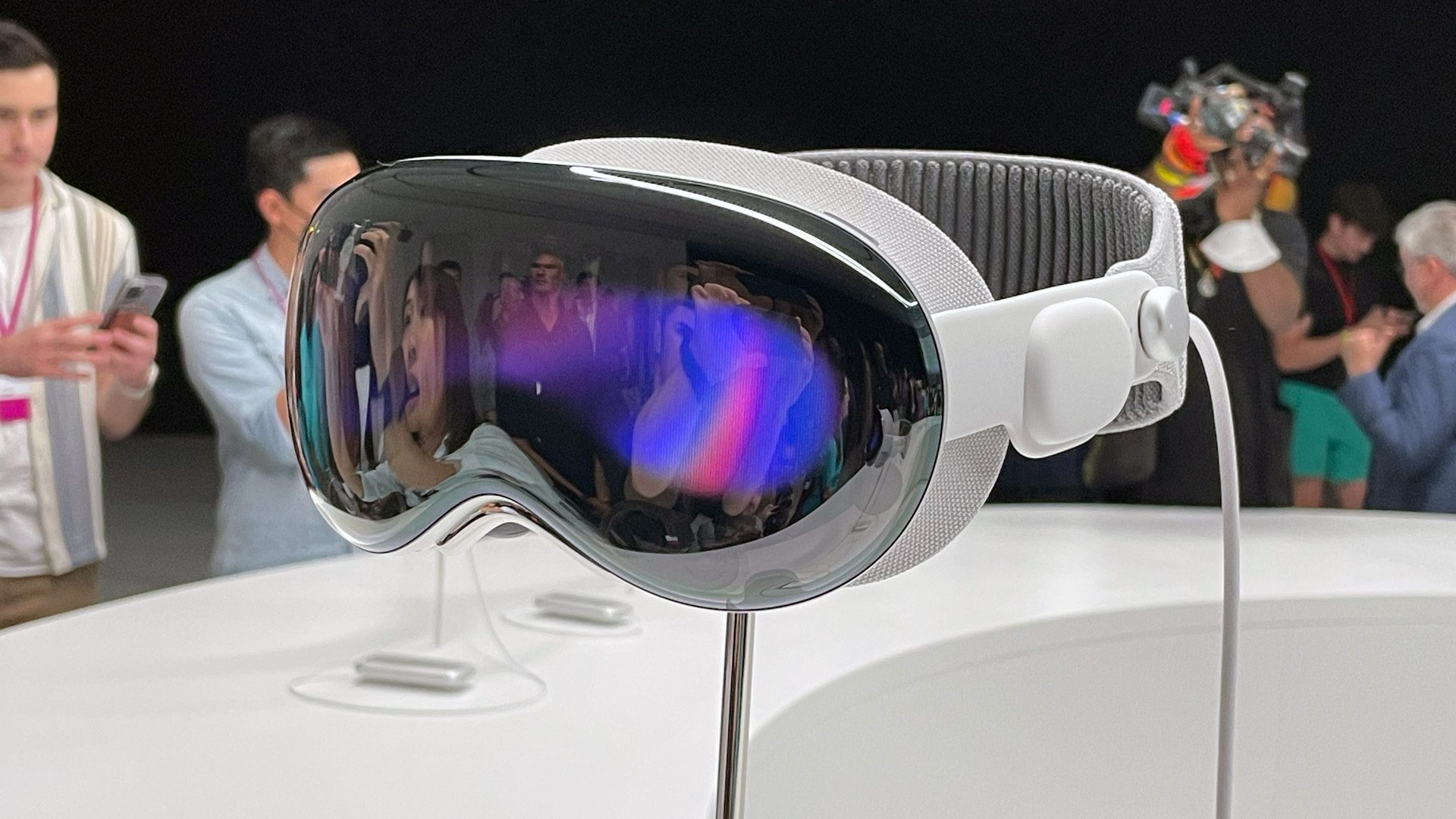Can a $3,500 headset replace your TV? We tried Vision Pro to find out
Apple Vision Pro Review —
We kick off our multi-part Vision Pro review by testing it for entertainment.
-
The Apple Vision Pro with AirPods Pro, Magic Keyboard, Magic Trackpad, and an Xbox Series X|S controller.
Samuel Axon
-
You can see the front-facing cameras that handle passthrough video just above the down-facing cameras that read your hand gestures here.
Samuel Axon
-
There are two buttons for Vision Pro, both on the top.
Samuel Axon
-
This is the infamous battery pack. It’s about the size of an iPhone (but a little thicker) and has a USB-C port for external power sources.
Samuel Axon
-
There are two displays inside the Vision Pro, one for each eye. Each offers just under 4K resolution.
Samuel Axon
-
Apple offers several variations of the light seal to fit different face shapes.
Samuel Axon
-
A close-up look at the Vision Pro from the front.
Samuel Axon
The Vision Pro is the strangest product Apple has introduced in the time I’ve been covering the company. By now, it’s well established that the headset is both impressively cutting-edge and ludicrously expensive.
You could certainly argue that its price means it’s only for Silicon Valley techno-optimists with too much money to burn or for developers looking to get in on the ground floor on the chance that this is the next gold rush for apps. But the platform will need more than those users to succeed.
Part of Apple’s pitch behind the price tag seems to be that the Vision Pro could replace several devices, just like the iPhone did back in the late 2000s. It could replace your laptop, your tablet, your 4K TV, your video game console, your phone or other communications device, your VR headset, and so on. If it truly replaced all of those things, the price wouldn’t seem quite so outrageous to some.
And those are just the use cases Apple has put a lot of effort into facilitating for the launch. Many of the most important uses of the company’s prior new product categories didn’t become totally clear until a couple of years and generations in. The iPhone wasn’t originally intended as a meditation aid, a flashlight, and a number of other common uses until third-party developers invented apps to make it do those things. And Apple’s approach with the Apple Watch seemed to be to just throw it out there with a number of possible uses to see what stuck with users. (The answer seemed to be health and fitness, but the device’s distinct emphasis on that took a bit of time to come into focus.)
So while I could write a dense review meandering through all the possibilities based on my week with the Vision Pro, that doesn’t seem as helpful as drilling in on each specific possibility. This is the first in a series of articles that will do that, so consider it part one of a lengthy, multi-step review. By the end, we’ll have considered several possible applications of the device, and we might be able to make some recommendations or predictions about its potential.
So far, I believe there’s one use case that’s a slam dunk, closer to clarity during launch week than any of the others: entertainment. For certain situations, The Vision Pro is a better device for consuming TV shows and movies (among other things) away from a dedicated theater than we’ve ever seen before. So let’s start there.
My (perhaps too) exacting standards
I know I’m not the usual TV consumer. It’s important to note that before we get too deep.
I bought my first OLED television (a 55-inch LG B6) in 2016. I previously had a 50-inch plasma TV I liked, but it only supported 1080p and SDR (standard dynamic range), and Sony had announced the PlayStation 4 Pro, which would support 4K games (sort of) and HDR (high dynamic range). Game consoles had always driven TV purchases in the past, so I sprung for the best I could afford.
I always cared about picture quality before I bought an OLED, but that interest turned into something more obsessive at that point. I was stunned at the difference, and I began to find it hard to accept the imperfections of LCD monitors and TVs after that. Granted, I’d always disliked LCDs, going straight from CRT to plasma to avoid that grayish backlight glow. But the comparison was even harsher once I went to OLED.
My fellow Ars Technica writers and editors often talk about their robust, multi-monitor PC setups, their expensive in-home server racks, and other Ars-y stuff. I have some of that stuff, too, but I put most of my time and energy into my home theater. I’ve invested a lot into it, and that has the unfortunate side effect of making most other screens I use feel inadequate by comparison.
All that said, some have argued that the Vision Pro is a solution in search of a problem, but there is one pre-existing problem I have that it has the potential to solve.
I travel a lot, so I spend a total of at least two months out of every year in hotel or Airbnb rooms. Whenever I’m in one of those places, I’m always irritated at how its TV compares to the one I have at home. It’s too small for the space, it’s not 4K, it doesn’t support HDR, it’s mounted way too high to comfortably watch, or it’s a cheap LCD with washed-out black levels and terrible contrast. Often, it’s all of the above. And even when I’m home, my wife might want to watch her shows on the big TV tonight.
I end up not watching movies or shows I want to watch because I feel like I’d be doing those shows a disservice by ruining the picture with such terrible hardware. “Better to hold off until I’m home,” I tell myself.
The Vision Pro could be the answer I’ve been waiting for. Those two displays in front of my eyes are capable of displaying an image that stands up to that of a mid-range OLED TV in most situations, and I can use it absolutely anywhere.
Can a $3,500 headset replace your TV? We tried Vision Pro to find out Read More »







